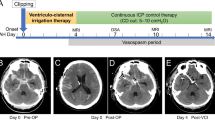Summary
In a series of 177 patients with ruptured supratentorial aneurysms we studied retrospectively the results of early and delayed operation without aggressive removal of subarachnoid blood clots but ventricular and cisternal drainage. The early and delayed groups were comparable demographically and neurologically. The overall results for the early group were a good outcome in 65%, poor outcome in 10% and death in 24%, compared to 53, 20 and 27% respectively in the delayed group. Thus, patients with an early operation and CSF drainage had better results. Permanent ischaemic neurological deficits due to cerebral vasospasm accounted for the poor outcome in 10 and 21% of the patients in the early and delayed groups, respectively and rebleeding accounted for the poor outcome in 5 and 10% in the early and delayed groups respectively.
The mean amount of haemoglobin in the cerebrospinal fluid from cisternal drainage was 6.4 g, corresponding to about 40 ml of whole blood, during the 12-day period after SAH. The level was higher in patients with larger subarachnoid clots or with symptomatic vasospasm than in those with smaller clots or without such vasospasm.
Early operation combined with ventricular and cisternal drainage is considered to be a useful surgical method for patient with a ruptured aneurysm.
Similar content being viewed by others
References
Asano M, Hidaka H (1979) Contractile response of isolated rabbit aortic strips to unsaturated fatty acid peroxides. J Pharmacol Exp Ther 208: 347–353
Farrar JK Jr (1975) Chronic cerebral arterial spasm: The role of intracranial pressure. J Neurosurg 43: 408–417
Fisher CM, Kistler JP, Davis JM (1980) Relation of cerebral vasospasm to subarachnoid hemorrhage visualized by computerized tomographic scanning. Neurosurgery 6: 1–9
Hori S, Suzuki J (1979) Early intracranial operations for raptured aneurysms. Acta Neurochir (Wien) 46: 93–104
Hunt WE, Hess RM (1968) Surgical risk as related to time of intervention in repair of intracranial aneurysms. J Neurosurg 28: 14–19
Hunt WE, Miller CA (19769 The results of early operation for aneurysm. Clin Neurosurg 24: 208–215
Jane JA, Winn HR, Richardson AE (1976) The natural history of intracranial aneurysms: Rebleeding rates during the acute and long term period and implication for surgical management. Clin Neurosurg 24: 176–184
Kassell NF, Boarini DJ, Adams HP Jr, Sahs AL, Graf CJ, Torner JC, Gerk MK (1981) Overall management of ruptured aneurysm: Comparison or early and late operation. Neurosurgery 9: 120–128
Kassell NF, Adams HP Jr, Torner JC, Sahs AL (1981) Influence of timing of admission after aneurysmal subarachnoid hemorrhage on overall outcome: Report of the cooperative aneurysm study. Stroke 12: 620–623
Kellogg EW, Fridovich I (1975) Superoxide, hydrogen peroxide, and singlet oxygen in lipid peroxidation by a xanthin oxidase system. J Biol Chem 250: 8812–8817
Klafta LA Jr, Hamby WB (1969) Significance of cerebrospinal fluid pressure in determining time for repair of intracranial aneurysms. J Neurosurg 31: 217–219
Ljunggren B, Brandt L, Kåström E, Sundbärg G (1981) Results of early operations for ruptured aneurysms. J Neurosurg 54: 473–479
Ljunggren B, Brandt L, Sundbärg G, Säveland H, Cronqvist S, Stridbeck H (1982) Early management of aneurysmal subarachnoid hemorrhage. Neurosurgery 11: 412–418
Ljunggren B, Säveland H, Brandt L (1983) Causes of unfavorable outcome after early aneurysm operation. Neurosurgery 13: 629–633
Ljunggren B, Brandt L, Säveland H, Nilsson P-E, Cronqvist S, Andersson K-E, Vinge E (1984) Outcome in 60 consecutive patients treated with early aneurysm operation and intravenous nimodipine. J Neurosurg 61: 864–873
Mizukami M, Kawase T, Usami T, Tazawa T (1982) Prevention of vasospasm by early operation with removal of subarachnoid blood. Neurosurgery 10: 301–307
Ozaki N, Mullan S (1979) Possible role of the erythrocyte in causing prolonged cerebral vasospasm. J Neurosurg 51: 773–778
Saito I, Ueda Y, Sano K (1977) Significance of vasospasm in the treatement of ruptured intracranial aneurysm. J Neurosurg 47: 412–429
Sakaki S, Motozaki T, Matsuoka K, Bitoh S (1980) A clinical study on the pathogenesis of brain damage caused by postoperative angiospasm following ruptured intracranial aneurysm. Med J Osaka Univ 31: 31–41
Sakaki S, Kuwabara H, Ohta S (1986) Biological defense mechanism in the pathogenesis of prolonged cerebral vasospasm in the patients with ruptured intracranial aneurysms. Stroke 17: 196–202
Sano K, Saito I (1978) Timing and indication of surgery for ruptured intracranial aneurysms with regard to cerebral vasospasm. Acta Neurochir (Wien) 41: 49–60
Sato J, Sato O, Kamitani H, Kanazawa I, Kokunai T (1979) Intracranial surgery and postoperative management of patients with ruptured aneurysm in acute and subacute stage: Basal cisternal drainage and lumbar subarachnoid drainage. Neurol Med Chir (Tokyo) 19: 173–179
Shiobara R, Toya S, Iisaka Y, Shizawa H, Ichikizaki K (1977) An evaluation of the continuous ventricular drainage for ruptured cerebral aneurysms: Treatment of postoperative increased ventricular fluid pressure. Neurol Med Chir (Tokyo) 17, Part II: 145–152
Sonobe M, Takahashi S, Otsuki T, Kubota Y (1981) Preventive effect on intracranial arterial vasospasm using combined ventriculo-cisternal and cisternal drainage. No Shinkei Geka 9: 1393–1397 (Jpn)
Sundt TM Jr, Whisnant JP (1978) Subarachnoid hemorrhage from intracranial aneurysms: Surgical management and natural history of disease. N Engl J Med 299: 116–122
Sutton HC, Roberts PB, Winterbourn CC (1976) The role of reaction of superoxide radical ion with oxyhemoglobin and methemoglobin. Biochem J 155: 503–510
Suzuki J, Yoshimoto T, Hori S (1974) Continuous ventricular drainage to lessen surgical risk in ruptured intracranial aneurysm. Surg Neurol 2: 87–90
Taneda M (1982) Effect of early operation for ruptured aneurysms on prevention of delayed ischemic symptoms. J Neurosurg 57: 622–628
Yasui N, Ito Z, Ohta H, Suzuki A (1982) Surgical problems and pathophysiology in severe cases with ruptured aneurysm in the acute stage. Acta Neurochir (Wien) 63: 163–174
Author information
Authors and Affiliations
Rights and permissions
About this article
Cite this article
Sakaki, S., Ohta, S., Kuwabara, H. et al. The role of ventricular and cisternal drainage in the early operation for ruptured intracranial aneurysms. Acta neurochir 88, 87–94 (1987). https://doi.org/10.1007/BF01404143
Issue Date:
DOI: https://doi.org/10.1007/BF01404143




